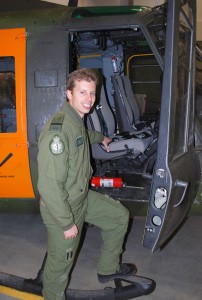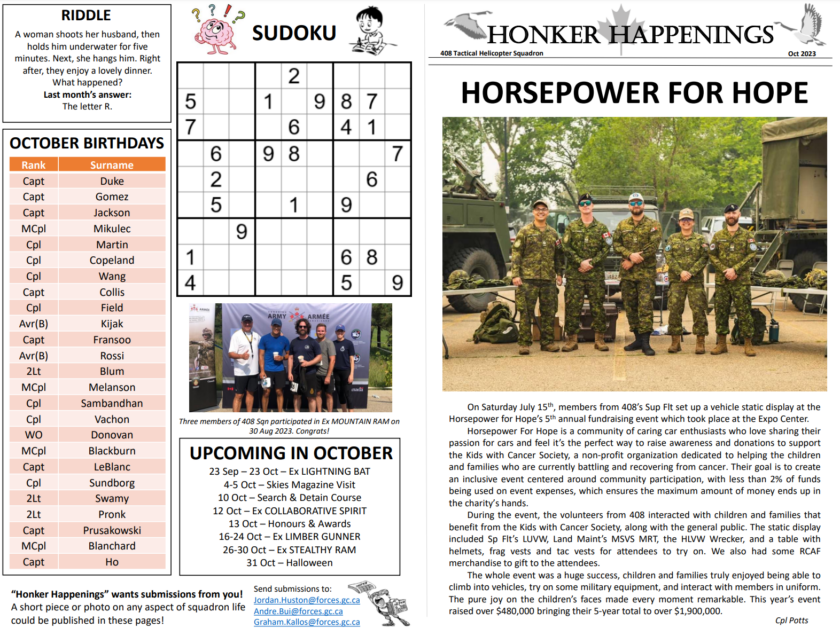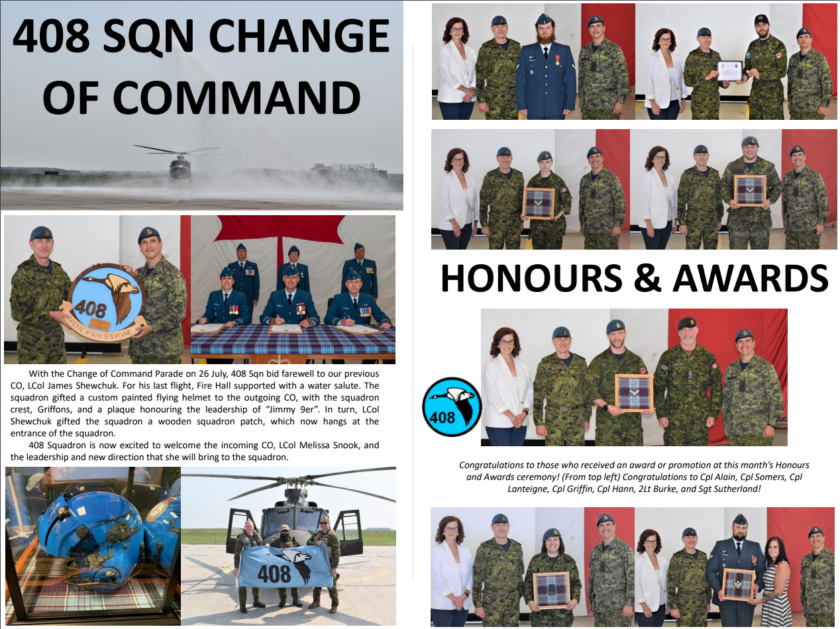Air Force Articles
A rookie’s perspective: Exercise Maple Resolve 2012
Nov. 15, 2012
by Second-Lieutenant Darren Kroeker
Second-Lieutenant Kroeker, a former commercial pilot, is a new member of the Canadian Forces. He is currently assigned to 408 Tactical Helicopter Squadron, in Edmonton, Alta. He recently took part in Exercise Maple Resolve 2012, a month-long high-readiness training exercise that involving nearly 4 000 soldiers at the Canadian Manoeuvre Training Centre, Canadian Forces Base Wainwright, Alta., and concluded November 2. 2Lt Kroeker describes what it’s like to be on a major exercise while still “learning the ropes” in a military environment.
I am new to the Canadian Forces—very new. As I write this, I have been “in” for 25 weeks and, when measuring a career in weeks actually makes sense, you know you are new.
Of those 25 weeks, I spent 15 weeks attending basic training in St. Jean, Que., one on leave and another attending a sea survival course. This leaves a grand total of eight weeks’ experience as an operations duty officer. I only mention this to try to convey how lost I was upon arriving at Canadian Forces Base Wainwright to take part in Exercise Maple Resolve as a 408 Tactical Helicopter Squadron operations duty officer.
As an “on the job training”(OJT) pilot who has yet to attend a single flying course, my day-to-day job around the squadron is to help out the experienced operations personnel whenever possible and do odd jobs as they come up.
Need to sign out some NVGs (night vision goggles)? I’m your man. Need a spreadsheet to track some equipment? You get the idea. The upshot is that working in operations keeps me centralized in the squadron. Basically, I learn a lot about how the place is run.
During the lead-up to Maple Resolve, I was informed that 408 Squadron was to provide air support to the “bad-guys” with our CH-146 Griffon helicopters in the (fictitious) conflict. As a squadron, our job would be to make life for the opposing troops as difficult as possible.
I was told my job would be to man operations at night. I would ensure that any pilots departing during my shift had all the right information and approvals they needed to get their job done, and ensure the aircrew had access to the most up-to-date data.
I had absolutely no idea how complex this operation was! When I arrived, I was surprised to learn that 408 Squadron operations would also be controlling a detachment of U.S. Army “Shadow” unmanned aerial vehicles (UAVs) and a CC-138 Twin Otter from 440 Transport Squadron, which is located in Yellowknife, N.W.T. Our opposition in this exercise was much bigger still, with the U.S. providing Chinook and Blackhawk helicopters.
Canadians also provided Griffons from 430 Tactical Helicopter Squadron in Valcartier, Que., and—coming in from 4 Wing Cold Lake, Alta.—two CC-130 Hercules making para-drops, Alpha Jets (from Top Aces) and CF-18 Hornets.
I had no idea how everything was going to fit together.
Upon our arrival in Wainwright, we started by setting up our work space: modular tents had to be put up, the hangar cleared for our Griffons and computer networks and radios wired up in the operations office. In addition, we had to do some serious organizing. I do not recall ever seeing so many laptops appear in such a small place and in such a short time. Our signals guys are amazing.
There was no scheduled flying on the first two nights I was on duty, and the ground troops had not begun their manoeuvres. My assigned tasks those nights were limited to answering the phone in case of emergency, and then waking up the appropriate personnel if they were needed.
Things picked up once we started flying operations, but it was when troops started moving that it got really interesting.
First, I had to learn about how airspace was being controlled. As a former commercial pilot, I am used to control zones being rather permanent fixtures—not changing for years at a time. In Wainwright, the airspace was extremely dynamic, what with different aircraft types of vastly different speed, size and operating altitude, and weapons ranges constantly changing between hot and cold. Thus, control zones are popping up and disappearing throughout the day.
I certainly learned the value of a laminated map and a grease pencil!
The amount of abbreviations and acronyms used for brevity was also mind-blowing. I will admit that there were countless instances where I was being issued instructions in which I understood less than 10 per cent of the terminology. Luckily, my blank stare would usually be enough to telegraph the need for further explanation.
We had the UAVs feeding us live pictures whenever the weather permitted, and it was amazing to see the battle plans taking shape from such a vantage point. Eventually I learned what all the different organisations and their roles were.
Even though we were playing the bad guys, and were supposed to lose in the end, I quickly discovered that the people I worked with only play to win. I enjoyed listening to them scheme well into the night—brain-storming ways to be as big a nuisance as possible to the enemy.
My first exposure as to how fast things happen was early during my shift on the evening of October 19.
“Gander Ops, this is Shadow Ops. Message. Over,” the radio crackled.
It was the American UAV team, bringing our attention to a line of troops moving into our area under the supposed cover of a moonless night.
With the Shadow’s excellent infrared camera, we were able to see clearly on our feed what they were looking at. We relayed the message to the command post and informed them that a two-ship formation of Griffons, equipped with C6 door guns, was standing by at a nearby forward operating base.
Command post staff had us move the Griffons to the location provided by the UAV, but even with the NVGs, it was far too dark for our guys to see the enemy from the air. One of the pilots in operations jumped up and shouted, “Ask Shadow if they can ‘sparkle!’” My eyebrows were raised at this point because I had no idea what this ‘sparkle’ was, but I was told that we were going to have the UAV illuminate the enemy with an infrared laser to allow our door gunners to see them with the NVGs.
Sure enough, it worked. The next thing we saw on the UAV feed was two Griffons popping into view. Only seconds later, we received a message from “Golf”, asking us to clear the airspace. I learned that “Golf” is military terminology for the artillery (G for Golf stands for “guns”) and they wanted to finish up what we had started.
All of this unfolded in just a few very intense minutes. The aircrew returned to base in a jovial mood; we had set our “enemy” back significantly that night. Now whenever the radio lights up, I sit up a little straighter and my heart beats a little faster because as one of the aircraft commanders so eloquently put it, “‘stuff’ is about to get real!”
All this excitement and I have been in the Forces for less than six months. And I have yet to even sit inside a military aircraft.
I think I am going to like this job.



